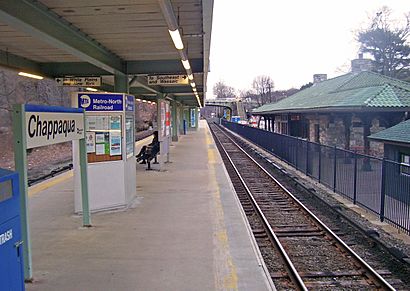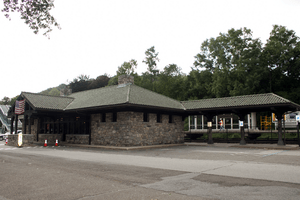Chappaqua station facts for kids
Quick facts for kids
Chappaqua
|
|||||||||||
|---|---|---|---|---|---|---|---|---|---|---|---|

View north from platform, 2009, with historic station on right
|
|||||||||||
| Location | 108 Allen Place, Chappaqua, New York | ||||||||||
| Line(s) | Harlem Line | ||||||||||
| Platforms | 1 island platform | ||||||||||
| Tracks | 2 | ||||||||||
| Connections | Bee-Line: 19 | ||||||||||
| Construction | |||||||||||
| Parking | 1,416 spaces | ||||||||||
| Disabled access | Yes | ||||||||||
| Other information | |||||||||||
| Fare zone | 5 | ||||||||||
| History | |||||||||||
| Opened | June 1, 1847 | ||||||||||
| Rebuilt | 1902, 2007 | ||||||||||
| Electrified | 1984 700V (DC) third rail |
||||||||||
| Previous names | Chapequa | ||||||||||
| Traffic | |||||||||||
| Passengers (2007) | 602,420 |
||||||||||
| Services | |||||||||||
|
|||||||||||
| Former services | |||||||||||
|
|||||||||||
|
Chappaqua Railroad Depot and Depot Plaza
|
|||||||||||
| Area | 2.7 acres (1 ha) | ||||||||||
| Built | 1902 | ||||||||||
| Architect | Nicholas Grant | ||||||||||
| Architectural style | Richardsonian Romanesque | ||||||||||
| MPS | Horace Greeley Related Sites TR | ||||||||||
| NRHP reference No. | 79003210 | ||||||||||
| Added to NRHP | April 19, 1979 | ||||||||||
The Chappaqua station is a busy train stop on the Metro-North Railroad's Harlem Line. It's located in Chappaqua, New York, a town called New Castle. Trains head to New York City every hour, and even more often during busy travel times. The trip to Grand Central Terminal in New York City takes about 52 minutes. This station is the first or last stop in the Zone 5 Metro-North fare area.
Right next to the modern station is an older building. This building was opened by the New York Central Railroad in 1902. It's still used today as a waiting area for passengers. This historic building is part of the Chappaqua Railroad Depot and Depot Plaza. It was added to the National Register of Historic Places in 1979.
The land for the station was given by the daughter of Horace Greeley. He was a famous newspaper editor and even ran for president. Horace Greeley moved to Chappaqua in the mid-1800s. He helped the town grow a lot. His daughter gave the land on one condition: a small park next to the station had to be kept up.
Contents
Station History: From Farms to Trains
Early Days in Chappaqua
Chappaqua was first settled by Quaker families. They moved inland from Long Island Sound in the 1740s. For about 100 years, Chappaqua was a farming community. It was centered around the meeting house, which is about 0.6 miles (1 km) north of today's downtown. The meeting house and some other old buildings from that time are still there. They are now part of the Old Chappaqua Historic District. This area is also listed on the National Register of Historic Places.
The Railroad Arrives
In 1846, the New York and Harlem Railroad built the first train tracks here. This slowly changed Chappaqua's economy and how the town was laid out. Farmers could now easily send their crops to New York City to sell them. Many farmers started growing "cash crops," which are crops grown to be sold for money. A few businesses began to gather around the first train depot. This was a few hundred feet north of where the station is now.
Horace Greeley's Influence
The train connection made it easier for people with ties to the city to live in Chappaqua. One of these people was Horace Greeley, the editor of the New York Tribune newspaper. He moved to Chappaqua in 1853 with his family. He wanted a quiet country place away from his busy job. He also wanted to try out the farming methods he wrote about.
Soon after moving, he built the first concrete dairy barn in the country. In 1864, he bought a large farm south of the station. He also made his farmhouse bigger. He lived there for the last nine years of his life.
A New Station for a Growing Town
Horace Greeley's daughter, Gabrielle, inherited his farm. As the 1800s ended, more city residents moved to Chappaqua. They often bought parts of the farm that had been divided into large home lots. By 1900, the old 1846 train depot was too small. It couldn't handle all the daily passengers and goods. Also, nearby buildings made it hard to get to the station.
People suggested different places for a new depot. There was some disagreement from owners of buildings near the old station. Then, Gabrielle Greeley offered to donate 2.7 acres of land. This is where the station stands today. She asked that a public park always be kept there. She also asked for an access road to be named Woodbine Avenue, after her mother's family.
Her offer was accepted, and the new station was built. It opened in 1902 with a big local celebration. This new station helped most of modern downtown Chappaqua grow. It also sped up the "suburbanization" of the community. This means more people moved from the city to live in Chappaqua. Gabrielle Greeley continued to divide her farm into smaller lots for homes until she died in 1937. The small park, with a statue of her father and a war memorial, remained as she had requested.
Modern Changes and Renovations
In the early 1970s, the Penn Central Railroad went bankrupt. This company had taken over the New York Central Railroad. Train services were then run by Conrail, and later by Metro-North Railroad. Metro-North was created by New York's Metropolitan Transportation Authority (MTA). In the 1980s, the new station with elevated platforms was built. A café called Café La Track opened in the old station building ten years later.
In the early 2000s, 20 parking spots at the station got electric car charging stations. This was part of a test program to encourage people to use electric cars. Drivers of these cars were guaranteed a spot. A few years later, the station had a $1.1 million renovation. During this time, the owners of Café La Track fought to stay. They used an online petition to stop a Dunkin' Donuts from taking their spot.
The historic station building became a restaurant called Chappaqua Station in 2015. It still kept much of its original look. As of 2019, the station building is home to Bobo's Cafe.
Station Layout and Surroundings
How the Station Works
The Chappaqua station has one long platform, about eight train cars long. This platform is raised high off the ground. It serves trains going in both directions.
- Mezzanine Level: This is where you enter and exit the station. It also connects to the parking area.
- Platform Level: This is where you catch your train.
- Track 2 is for trains heading south towards Grand Central Terminal in New York City.
- Track 1 is for trains heading north towards Southeast.
- The station has an island platform. This means you can get on or off trains from either the left or right side of the platform.
Buildings and Grounds Around the Station
The station is in the southwest part of downtown Chappaqua. It's in a low area surrounded by hills. The two train tracks run straight, going northeast to southwest. They run next to the Saw Mill River Parkway and the start of the Saw Mill River. Quaker Road goes over the tracks just north of the station.
East of the station, across South Greeley Avenue, are shops and the Robert E. Bell Middle School. South of the station is the Church of St. Mary the Virgin. This church is also listed on the National Register because of its connection to the Greeley family. A baseball field is between the station and New Castle's town hall and the Chappaqua library.
Woodburn Avenue is the entrance road to the station. The parking lot is shaped in semicircles. A statue of Horace Greeley and a war memorial are across Allen Place from the old station building. The stairs to the modern station are right next to them.
The Historic Station Building
The old station building is made of stone. It has a tiled roof with two stone chimneys. On its west side, there's a covered entrance called a porte-cochère. This area was for carriages or cars to drop people off. An arcade (a covered walkway) runs along the tracks. This used to shelter passengers. Now, the tracks are fenced off, and you enter the trains through the modern station.
The Modern Station
A walkway and stairs made of glass and aluminum lead up to a bridge over the tracks. There's also an elevator in a brick tower. Ticket machines are on this bridge. On the west side of the bridge, another enclosed stairwell and elevator go down to the raised concrete platform between the tracks.
The platform is long enough for eight train cars. It extends south of the bridge and also north, past the Quaker Road bridge. A roof covers the first 100 feet (30 m) of the platform. Along the platform, you'll find streetlights, shelters, and vending machines.
The historic station building became a café in 2015. The old ticket counter is now a checkout counter. The café still has many original features, like the waiting area benches. The inside is decorated with wood, from the floor to the walls and ceiling.
Train Services at Chappaqua
Most trains that stop at Chappaqua are electric trains. These are usually M7As, but sometimes older M3As are seen. Diesel trains, which serve the northern parts of the Harlem Line where there are no electric tracks, pass through during busy morning and evening hours. Some of these diesel trains also stop here.
As of April 2013, 15 trains stop at the station during the busy morning hours. Three of these trains start further up the line. Chappaqua is their last local stop before they go express to White Plains, 125th Street, and Grand Central. During non-busy hours, trains run hourly. Some extra trains start in Mount Kisco. They stop at Pleasantville before becoming express trains to North White Plains, White Plains, and the two stops in Manhattan.
The evening busy hours have the same trains as the morning, but going in the opposite direction. On weekends and holidays, trains generally run hourly. There are also a few extra trains to and from Mount Kisco.





